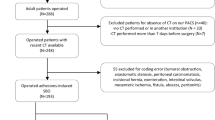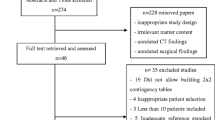Abstract
Introduction
Adhesion-related small-bowel obstruction (ASBO) can be managed without surgery in selected patients. The aim of this study was to validate three previously published computed tomography (CT) models that predict need for surgery.
Methods
A retrospective study of patients with ASBO admitted to a tertiary referral hospital between November 2009 and April 2015 was conducted. Data on clinical variables were extracted from medical records. CT signs were assessed by a radiologist who was blinded to whether or not the patients required surgery. Three previously published models were validated by testing their ability to predict need for surgery.
Results
The cohort comprised 233 patients with ASBO (mean age 69.7 years, 47.6% male), of whom 73 (31.3%) required surgery. A predictive model using a combination of mesenteric oedema, free intraperitoneal fluid and absence of small-bowel faecalisation had a sensitivity of 38% [95% CI 27–50%], specificity of 88% [81–92%], positive likelihood ratio (LR+) of 3.1 [1.6–5.1] and negative likelihood ratio (LR−) of 0.7 [0.6–0.8]. Only the results of one previously published model (which used a combination of obstipation, free intraperitoneal fluid and high-grade or complete obstruction) could be reproduced. This model had a potentially clinically useful LR+ of 2.9 [1.1–7.4] and LR− of 0.9 [0.8–1.0]. The poor performances of the other two models may be partially explained by measurement bias.
Conclusion
The performances of the previously published predictive models in this validation study were varied. Future attempts to develop models should use clearly defined, standardised and reproducible predictors wherever possible.
Similar content being viewed by others
References
Di Saverio S, Coccolini F, Galati M et al (2013) Bologna guidelines for diagnosis and management of adhesive small bowel obstruction (ASBO): 2013 update of the evidence-based guidelines from the world society of emergency surgery ASBO working group. World J Emerg Surg 8:42
Pricolo VE, Curley F (2016) CT scan findings do not predict outcome of nonoperative management in small bowel obstruction: retrospective analysis of 108 consecutive patients. Int J Surg 27:88–91
Williams SB, Greenspon J, Young HA et al (2005) Small bowel obstruction: conservative vs. surgical management. Dis Colon Rectum 48:1140–1146
Zielinski MD, Eiken PW, Bannon MP et al (2010) Small bowel obstruction—who needs an operation? A multivariate prediction model. World J Surg 34:910–919. doi:10.1007/s00268-010-0479-3
Zielinski MD, Eiken PW, Heller SF et al (2011) Prospective, observational validation of a multivariate small-bowel obstruction model to predict the need for operative intervention. J Am Coll Surg 212:1068–1076
Chang WC, Ko KH, Lin CS et al (2014) Features on MDCT that predict surgery in patients with adhesive-related small bowel obstruction. PLoS ONE 9:e89804
Kulvatunyou N, Pandit V, Moutamn S et al (2015) A multi-institution prospective observational study of small bowel obstruction: clinical and computerized tomography predictors of which patients may require early surgery. J Trauma Acute Care Surg 79:393–398
Ceresoli M, Coccolini F, Catena F et al (2016) Water-soluble contrast agent in adhesive small bowel obstruction: a systematic review and meta-analysis of diagnostic and therapeutic value. Am J Surg 211:1114–1125
Lien I, Wong SW, Malouf P et al (2014) Effect of handover on the outcomes of small bowel obstruction in an acute care surgery model. ANZ J Surg 84:442–447
McGee S (2002) Simplifying likelihood ratios. J Gen Intern Med 17:646–649
Debray TP, Vergouwe Y, Koffijberg H et al (2015) A new framework to enhance the interpretation of external validation studies of clinical prediction models. J Clin Epidemiol 68:279–289
Moons KG, Royston P, Vergouwe Y et al (2009) Prognosis and prognostic research: what, why, and how? BMJ 338:b375
Sheedy SP, Earnest F, Fletcher JG et al (2006) CT of small-bowel ischemia associated with obstruction in emergency department patients: diagnostic performance evaluation. Radiology 241:729–736
Millet I, Taourel P, Ruyer A et al (2015) Value of CT findings to predict surgical ischemia in small bowel obstruction: a systematic review and meta-analysis. Eur Radiol 25:1823–1835
Millet I, Ruyer A, Alili C et al (2014) Adhesive small-bowel obstruction: value of CT in identifying findings associated with the effectiveness of nonsurgical treatment. Radiology 273:425–432
Author information
Authors and Affiliations
Corresponding author
Rights and permissions
About this article
Cite this article
Yang, P.F., Rabinowitz, D.P., Wong, S.W. et al. Comparative Validation of Abdominal CT Models that Predict Need for Surgery in Adhesion-Related Small-Bowel Obstruction. World J Surg 41, 940–947 (2017). https://doi.org/10.1007/s00268-016-3796-3
Published:
Issue Date:
DOI: https://doi.org/10.1007/s00268-016-3796-3




